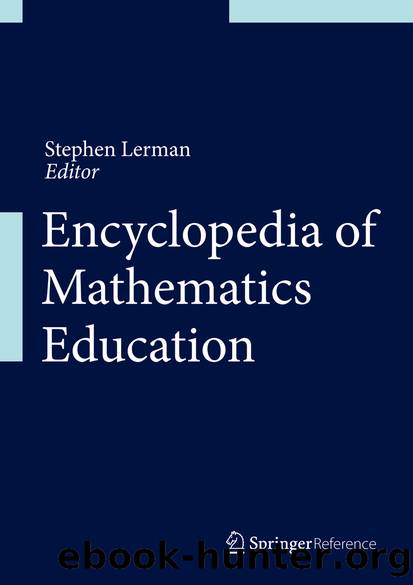Encyclopedia of Mathematics Education by Stephen Lerman

Author:Stephen Lerman
Language: eng
Format: epub
Publisher: Springer Netherlands, Dordrecht
Definition
Interdisciplinarity denotes the fact, quality, or condition that pertains to two or more academic fields or branches of learning. Interdisciplinary projects tend to cross the traditional boundaries between academic disciplines.
Interdisciplinarity and Mathematics (Education)
The very idea of an (academic) discipline embodies strength and weaknesses. On the one hand, discipline means orderly conduct that is the result of physical and mental discipline. Considerable discipline in the second sense of the word is required to be and become an outstanding practitioner in the former sense of the word. The strength of being disciplined (e.g., doing mathematics) is also the weakness. Those who are very disciplined in their ways of looking at problems also are very limited in the ways they can see a problem. The contradictions arising in and from interdisciplinary projects are in part linked to this limitation. To overcome the limitation of disciplinary approaches, there has been an increasing interest in establishing connections between different fields. In mathematics and mathematics teaching, interdisciplinarity often faces problems especially at the high school level because in other fields (e.g., biology, chemistry, or physics), mathematics is considered to be a mere service discipline rather than real mathematics. The curricular intentions in these subject matters and mathematics is different, which often leads to tensions of where to place the emphasis. In actual school practice, there tends to be very little work across disciplines and curriculum integration.
From the perspective of activity theory, the origin of these problems is easily understood (Roth and Lee 2007). This is so because activity theorists accept that “the production of ideas, conceptions, consciousness is initially immediately intertwined with material activity and the material intercourse of humans, language of real life” (Marx and Engels 1969, p. 26). Material activity and a focus on a particular object of activity involve different forms of relations between people. Because the relations between people ultimately become higher psychological functions (Vygotsky 1989), very different forms of knowing and understanding emerge within each discipline: consciousness and cognition are fundamentally situated (see Situated Cognition in Mathematics Education). That is, with each discipline, there are different forms of consciousness; and there are different collective object/motives (see Activity Theory in Mathematics Education) pursued in each discipline even if they work with precisely the same material objects. Interdisciplinarity requires new object/motives, which inherently differ from the object/motives that characterize the root disciplines. What is of interest in one discipline is not of interest to another. But, as the interdisciplinary design work for modern technology in the workplace shows (and current scientific practices more widely), these new interdisciplinary endeavors, while helping communication across the disciplines, create new objects and discourses that are different from the root disciplines (Ehn and Kyng 1991). Although school contexts differ from workplace settings, similar issues arise especially at the high school level where integration of mathematics with other school subjects tends to be rare. It does not come as a surprise, therefore, when as a result of interdisciplinary projects, mathematics teachers no longer find their mathematics just as other specialist teachers no longer find sufficient attention to their discipline in joint projects.
Download
This site does not store any files on its server. We only index and link to content provided by other sites. Please contact the content providers to delete copyright contents if any and email us, we'll remove relevant links or contents immediately.
| Arts & Humanities | Health |
| Language Arts | Library Skills |
| Mathematics | Reading & Phonics |
| Science & Technology | Social Studies |
The Art of Coaching Workbook by Elena Aguilar(48057)
Trainspotting by Irvine Welsh(20052)
Twilight of the Idols With the Antichrist and Ecce Homo by Friedrich Nietzsche(17705)
Fangirl by Rainbow Rowell(7832)
Periodization Training for Sports by Tudor Bompa(7327)
Change Your Questions, Change Your Life by Marilee Adams(6639)
This Is How You Lose Her by Junot Diaz(5764)
Grit by Angela Duckworth(4734)
Red Sparrow by Jason Matthews(4661)
Asking the Right Questions: A Guide to Critical Thinking by M. Neil Browne & Stuart M. Keeley(4573)
Paper Towns by Green John(4168)
Room 212 by Kate Stewart(4102)
Ken Follett - World without end by Ken Follett(3972)
The Sports Rules Book by Human Kinetics(3585)
Housekeeping by Marilynne Robinson(3401)
The Motorcycle Diaries by Ernesto Che Guevara(3332)
Introduction to Kinesiology by Shirl J. Hoffman(3299)
Exercise Technique Manual for Resistance Training by National Strength & Conditioning Association(3290)
Double Down (Diary of a Wimpy Kid Book 11) by Jeff Kinney(3272)
